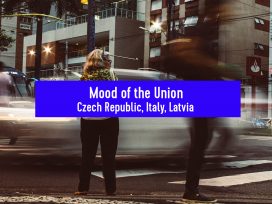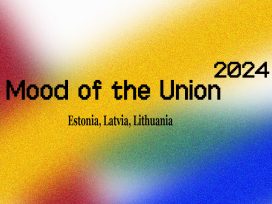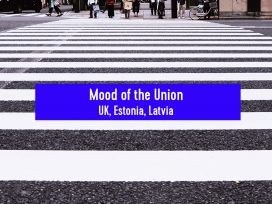I have always been fascinated by cafés of every conceivable kind and the role they play in people’s lives. The kafejnica is a particularly intriguing example of a café, and one that is uniquely suited to Latvian society (or rather the lack of it). I was quick to adapt to kafejnica culture when I first came to Latvia, and I certainly learned more about the country, in the anthropological sense of the word, from sitting for countless hours in some backstreet kafejnica than I did by sitting in any of Riga’s abundant “nice” new cafés.
I recently had a conversation with a well-known poet on this subject. When I told him that I had recently enjoyed a wonderful night in Daile kafejnica (a sublime example of the genre), drinking cheap brandy, and talking across a candlelit table with Radio Skonto playing in the background, he said “ugh,” and laughingly suggested that I was merely romanticizing kafejnicas because I was a foreigner.
But I know the kafejnica far too well to be guilty of that. A few years ago I sometimes used to go to Savanna kafejnica on Stabu Street for a nightcap just because it was on my way home. It was a truly disgusting place, full of dangerous and unpleasant looking people, and dangerous and unpleasant looking food, but at that time I was naïve enough to think I could sit there and observe the plastic plants and floral wallpaper and empty-eyed customers with diplomatic immunity.
One Saturday night, I stopped in there for a quick drink before going home. It was about 11 pm and it was an excruciatingly hot and humid night. A storm was in the air and my eyes were swollen and my thoughts brooding with a sense of anticipation. The place was crowded with some extremely dubious people, but I strode past them to the bar and ordered a brandy. There was nowhere to sit, so I decided to drink it outside. The wind was stirring ahead of the storm and the tram wires were swaying, causing the surreal streetlight to swish against an old wooden house across the street. It was such a beautiful sight that I decided to have one more drink before calling it a night.
After paying for my 50 grams of brandy, I was about to go back outside when a young Russian man came up to me and said something to me with a snarling face. Without knowing what was happening, he suddenly swung a punch at me. Luckily he was so drunk that I stepped back and his fist went well wide of my face, although my brandy spilt over the floor. I looked around, my heart manically beating. No one was paying the least attention to this thoroughly unprovoked attack. Some old men carried on playing the slot machines. Others phlegmatically glanced up from their conversations. One or two people were even chuckling at this little sideshow.
I backed up against the bar, still holding my empty brandy glass, unable to utter a word in my defence. Just then a moustached man who I had seen in there several times before stepped in between us but my assailant turned on him instead, head-butting him and laying in to him with a savagery I found nauseating. They fell to the floor in a tangle, before the young Russian who had started it all suddenly burst into tears and began rolling around on the floor groaning. I felt sick.
I went back to the bar and asked the barmaid to refill my glass and could hardly believe it when she asked me to pay for it. “But I was just attacked here by one of your customers,” I protested. She indifferently shrugged her eyebrows at me, and I called it a very sad night.
The traditional European café has long been romanticized as a bastion of free thought, an almost sacrosanct social space that is at once a part and apart from the society in which it functions. It has played an integral part in European history since the eighteenth century, providing a smoky birthplace for everything from artistic movements (the Dada manifesto was signed in a Zurich café), to seminal works of philosophy (Sartre’s Being and Nothingness was written almost entirely out of a Montmartre café), to the backdrop for films, theatre, and literature (Marguerite Duras’ Moderato Cantabile was set wholly in a provincial café).
The Latvian kafejnica , on the other hand, serves as a social repository for those lacking any other social space to call their own. The only person you will see reading in them is, perhaps, the barmaid, desperately trying to overcome the tedium of working a 14-hour shift with the help of a good romance.
Riga has seen an influx of new cafés in recent years, all of which are distinctly cafés, as opposed to kafejnicas : Coffee Nation, Coffee World, Coffee Planet, Double Coffee, and so on. The smooth and subtle “C” of coffee has superseded the clumsy and parochial “K” of kafija in this new scheme of things. Yet this new generation of Riga cafés is all much the same, just as kafejnicas are all much the same in their way.
The café is a truly unique social space. Where restaurants by design make people self-conscious, and bars make people self-oblivious, the café encourages the individual to exist in a temporarily heightened and idealized state of mind. In the new generation of Riga cafés, this existence amounts to a parody, a lifestyle, an idea, which is made up of a lexicon of symbols that have been imported wholesale, from the aesthetics of the interior design, to the items for sale on the menu, to the atmospherics of the music, to the flashing white teeth which signpost the enthusiastic tête-à-têtes between people leaning excitedly over their tables.
In such places, the coffee is merely an accessory or a prop, and the café itself a carefully contrived backdrop, which serves to objectively affirm the self-image of those who go there. It is an intrinsically pretentious environment because it is a system of subtly stylized signs that must be recognized in order to be appreciated, which then reflects back on the individual. In other words, you must have an affinity with such a place to feel at ease there. But when people pop into these cafés on their lunch break, they little realize that they are still busy working as they sip their café latte and nibble on their croissants.
The kafejnica, on the other hand, provides a far more fecund environment for thought to tackle itself in. Some of my most emotionally and philosophically satisfying conversations were inspired by the strange and even tragic world of the kafejnica , with its ashamedly dim lighting, its sigh-stained wallpaper, its disgustingly green plastic plants, its array of cheap alcohol honestly laid out along the shelves behind the counter with price tags dangling from each bottle, and its slot machines desperately flashing away in a corner, waiting for someone to come and feed them some coins.
The characteristic interior of a kafejnica is almost hysterically kitsch in the sense that it is a sort of desperate caricature. But where restaurants such as Lido and its many imitators attempt to resemble some mythical Latvia carved out of wholesome wood, where smiling waitresses wearing folk costumes attend to the customerfolk, and Latvian proverbial wisdom is etched into the rafters in Gothic script, the kafejnica is a more telling historical exhibit of the country that bore it.
The kafejnica is an aesthetic and conceptual chaos, born of a history that never was. But the kafejnica is everywhere, and it is a fascinatingly homogenous entity. The characteristic proof of its existence can be found in such details as those uselessly thin waxed paper serviettes that simply smear the food back over you instead of wiping it away. It can be found in the repugnant swill that passes for food in such places, all ornately signed by the chef with a flourish of dill. It can be found in the omnipresent atmosphere of Radio Skonto - the choice of music for the kafejnica - whose DJs descend into melancholy as the night wears on, and whose playlists mostly revolve around ’80s synthesizer pop.
The kafejnica exists in a temporal and cultural vacuum, which is why they are all remarkably alike. For me, it is living proof of the poverty of philosophy and its cultural offshoots in Latvia. The deep-rooted historical tensions and conflicts that gave rise to this wonderful institution have yet to be resolved. The kafejnica is, in the extreme, the embodiment of self-doubt.
On a recent visit to the Daile kafejnica on Barona Street, I noticed a glitterball dangling from the ceiling above my table by the window. It was a Friday night, and the peroxide blonde barmaid turned up a painfully familiar Abba song when it came on the radio. I sat there talking with a dear friend over brandy, and I felt strangely elated being there. Our conversation was subtly affected by our surroundings, by the tiny details that caught our eye while in mid-thought, such as the plastic vines entwined around the counter, or the illuminated picture of a waterfall on the wall, and I felt galvanized by the sheer chaos and kitsch of it all.
There is an irresistibly sensual sadness in such an environment, which is inevitable, given this fatal juxtaposition of things, which affirm each other by negating each other. It’s all very romantic, actually. The sadness one feels in places such as Coffee Nation arises from a feeling of disbelief, while the sadness inspired by a kafejnica is one of pure grief.
That night I found myself talking more eloquently than ever about the past simply to embellish the present. There was no other choice. The kafejnica is an intrinsic magnet for nostalgia that sucks you into a sort of backwards-looking black hole of regret and moroseness, unless you outthink yourself and in doing so subvert the significance of your surroundings to better suit you.
In England, the only comparable thing to the kafejnica is popularly known as a greasy-spoon café. They sprung up in the 1950s and 1960s when a wave of Italian immigrants opened them all around the country. They typically had names like Mario’s Café or Joe’s Café and stereotypically served up huge greasy English breakfasts to tables of tabloid newspaper-reading workmen. I was fascinated by these places as a teenager, although at that time they were scorned by any person with the least pretension of being a sophisticated and cultured intellectual. By the 1990s, however, they became somewhat fashionable and they began to lose the sad charm that so endeared them to me.
But the greasy spoon café, even in its glorious heyday of chequered tablecloths and disgustingly milky coffees, could not compare to the bizarre beauty I find in the kafejnica .
The time of the kafejnica as I know and love it is probably numbered though. They are increasingly having their “Ks” renovated into “Cs”, and are assuming a new identity, which is no less kitsch or confused than before, but it is an altogether cleaner and more orderly look, and wholly lacking in character. They symbolize nothing more than the fatuous mentality that dreamed up one of the most ridiculous phrases in the Latvian language - eiroremonts . The historic schism that separates the kafejnica from the café has not been overcome, but merely plastered over.
As for me, I will remember with great affection places such as the Brooklyn Bridge kafejnica on Wagner Street in the Old Town. I had many wonderful nights there during an extremely hot summer a couple of years ago. The walls were adorned with images of the Manhattan skyline, as well as a mounted fish on a wooden plaque that sang “Take Me To the River” if you pushed a button. It was a tiny place with only five tables, and felt excruciatingly intense regardless of whether it was full or empty.
It was one of a variety of cafes and kafejnicas on my little circuit of special places I used to suit my multitude of moods. If my friend and I were feeling melancholy, we headed straight for the Brooklyn Bridge kafejnica . We would ceremoniously order our drinks, twiddle our glasses around on the table, squint at each other as we talked, and all the while feed off the anachronistic confusion of our surroundings. By the time we left there, we would forget that we had ever been sad.
The Brooklyn Bridge kafejnica closed down a little more than a year ago and was replaced by yet another amusement arcade ( spelu zale ). It was the last kafejnica of its kind in the Old Town, which has now become wholly colonized by the café. But if you squint hard enough in one of these charming new establishments, and twiddle your cup of coffee in the right way, you might still glimpse a little of the kafejnica there. After all, you can’t extract a café from a kafejnica just like that.





